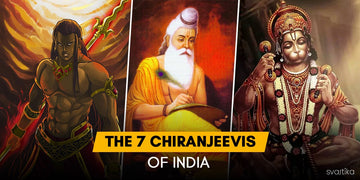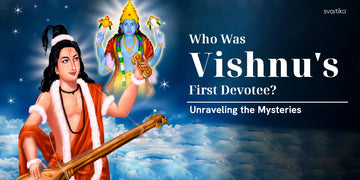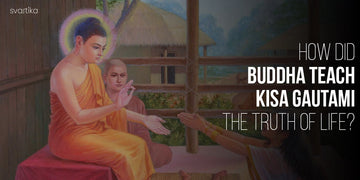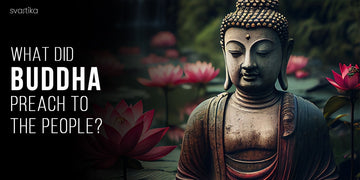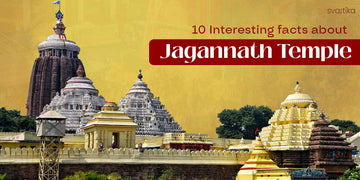Have you ever caught yourself wondering, What if immortality was real? In Hindu mythology, it’s not just a fantasy! It’s a reality for a group of seven remarkable beings, otherwise known as the 'Sapta Chiranjeevi'.
These fascinating figures are believed to live on earth, untouched by the passage of time and death itself!
They all come from different Yugas, some are here because of their unwavering devotion, some because of a curse, and some because of their divine mission to protect dharma.
They are all believed to help the 10th avatar of Bhagwaan Vishnu, Kalki, in restoring balance and righteousness in the world.
Sounds fascinating, right? These immortals have lived on for centuries, their stories are full of adventure, wisdom, mistakes, experiences, and powerful lessons.
But who exactly are these seven Chiranjeevis? What makes them so special, and why are they such an important part of Sanatan belief?
In this blog, we’ll explore the realm of these 7 immortals, uncovering their timeless tales and understanding the wisdom they carry.
The Tale of 7 Immortals Still Alive in Kali Yuga
1. Lord Hanuman

Lord Hanuman, the mighty deity of Hindu mythology, is revered and adored for his immense strength, unwavering devotion, and selfless service to Lord Rama.
Known as the epitome of loyalty and righteousness, Lord Hanuman holds a special place in the hearts of millions.
Born to Anjana and Kesari, Lord Hanuman's life is shrouded in fascinating tales. He is known to have possessed extraordinary powers right from his childhood.
As a young monkey, he mistook the rising sun for a delicious fruit and soared towards it, only to be struck down by Indra, the king of gods.
In response, Lord Hanuman's father, Kesari, requested Vayu, the wind god, to withdraw his life force from the universe until Lord Indra revived him.
Thus, Lord Hanuman became invincible, gaining immortality and eternal youth. This is why Lord Hanuman is believed to be still alive, eternally dwelling among us.
Lord Hanuman's devotion to Lord Rama is unparalleled. He played a pivotal role in the epic Ramayana, aiding Lord Rama in his quest to rescue his beloved wife, Sita, from the clutches of the demon king, Ravana.
Lord Hanuman's numerous heroic deeds showcased his unwavering dedication, unparalleled strength, and unmatched wisdom.
It is due to his immortality and eternal presence that Lord Hanuman is considered one of the 7 immortals of Hindu mythology. The immortality bestowed upon him by Lord Indra grants him eternal life and the ability to serve as a guiding light for generations to come. It is due to this reason that you will find a hanuman murti in the homes of his devoted followers.
His timeless existence symbolises the eternal devotion and devotion to righteousness that Hindus strive to embody.
Lord Hanuman's popularity extends far beyond religious boundaries. He is revered for his valor, selflessness, and unwavering faith, serving as an inspiration to people from all walks of life.
His character teaches valuable lessons of humility, courage, and loyalty, making him a beloved figure in Hindu mythology.
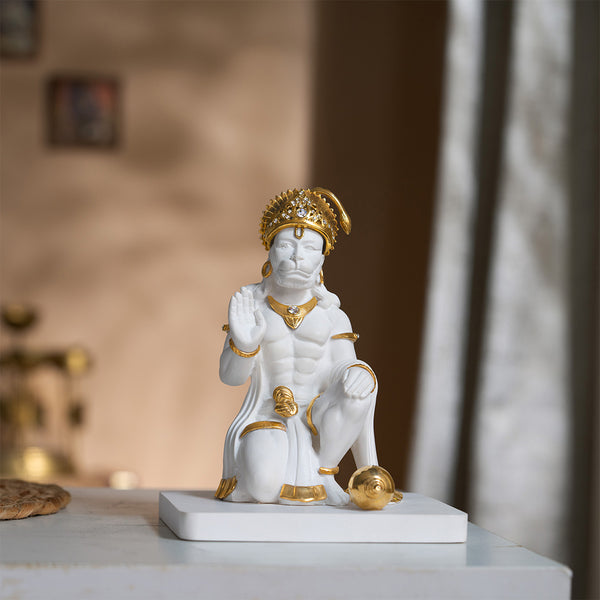
Premium White & Gold Hanuman Ji Kneeling Statue (6.5 Inch)
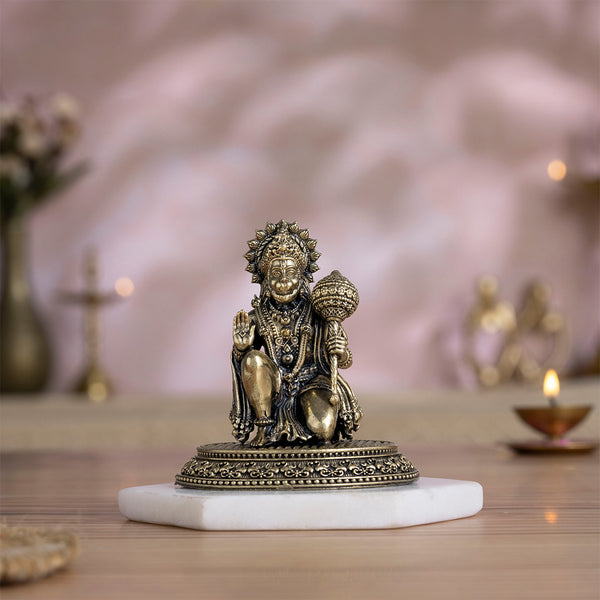
Brass Hanuman Idol Blessing in Abhaya Mudra (3.5 Inch)
2. Ashwathama

Mahabharata stands till date as one of the most epic tales ever written with mighty Arjuna, the generous Karnan, the sly Lord Krishna, fierce Draupadi and a host of other interesting characters.
Ashwathama remains to be one of the much discussed figures in history. Ashwathama was the son of Dronacharya, a legendary warrior and teacher. Ashwathama literally translates to "the horse-voiced" in the Mahabharata.
It could also refer to an individual who has the vigour of a horse. He was rumoured to have divine abilities thanks to the gem Lord Shiva placed on his forehead.
Ashwathama, fighting on behalf of the Kauravas, decided to assassinate the five Pandava brothers in their camp at midnight, despite the fact that it was against the ethics of war to attack after sunset, as the battle of Kurukshetra, also known as the Mahabharata War, was nearly over.
Ashwathama killed the Pandava sons while they were out of the country because he mistook them for the five brothers.
When the Pandavas returned home and saw what had happened, they were furious and set out to kill Ashwathama. It was too late when Ashwathama tried to find forgiveness for his sin.
In self-defense, he attempted to attack the Pandavas with the divinely inspired and extremely destructive Bramhashirastra. Arjuna countered by invoking the same, seeing as how he, too, was a student of Dronacharya.
Lord Krishna saw what was happening and begged them to put down their weapons, saying that they threatened to trigger a cataclysmic event that would have destroyed the planet.
Arjuna disarmed himself, but Ashwathama had never been shown how and so remained armed. He aimed the weapon at a single target, who turned out to be Uttara, Arjuna's pregnant daughter-in-law.
The use of the weapon resulted in the loss of the unborn child, bringing an end to the Pandava family dynasty. Lord Krishna was so outraged by this heinous deed that he cursed Ashwathama.
As a result, Ashwatthama will endure unending suffering until the conclusion of this Kaliyuga.
3. Parashurama

A name heard by all and hailed by all, Parashurama is a divine entity who is considered to be one of the 7 immortals who are still alive.
He is the sixth incarnation from the 10 avatars of Vishnu. He is the son of Renuka and the Saptarishi Jamadagni.
Parshurama is the sixth avatar of Vishnu and lived during the most recent Dvapara Yuga.
After enduring a severe penance, he was rewarded with an axe known as a parashu, and Shiva was the one who instructed him in the ways of the martial arts.
After his father was murdered by the powerful monarch Kartavirya, Parashurama became famous for destroying twenty-one times as many Kshatriyas as he could find over the world.
He was a significant figure in both the Mahabharata and the Ramayana, particularly in the Mahabharata, when he served as a guide for Bhishma, Karna, and Drona.
Together with other warriors, Parashurama repelled the oncoming tides in order to safeguard the regions of Konkan, Malabar, and Kerala.
According to legend, Parashurama will serve as a mentor and teacher to Kalki, the last and most powerful Vishnu Avatar.
He will assist him in performing penance so that he might obtain celestial weapons and knowledge that would help save humanity at the end of the current Yuga, the Kaliyuga.
Parashurama will help Kalki receive celestial weaponry and knowledge that will be helpful in saving mankind at the end of the present Yuga.
4. Mahabali

Mahabali, also known as Bali, was the son of Devamba and Virochana and ruled the "daitya" kingdom that included modern-day Kerala.
His grandfather, Prahlada, raised him and gave him a firm grounding in virtue and devotion. He was revered as a just, wise, benevolent, king and was considered to be an ardent devotee of Lord Vishnu.
Bali would succeed his grandfather as king of the Asuras, and the kingdom would enjoy a period of relative stability and growth throughout his rule.
Later, he extended his domain by subjugating the entire planet to his benign rule; he even overthrew Indra and the Devas to take control of the afterlife and the heavens.
After being defeated by Bali, the Devas went to Vishnu, their patron, and begged him to give them back control of Heaven.
To ensure his continued dominance over the multiverse, Bali had initiated the Ashwamedha Yaga in Heaven at Sukracharya's suggestion.
During an Ashwamedha Yagna, King Bali, in a spirit of great generosity, was granting wishes to his people.
Meanwhile, Lord Vishnu appeared in the area as Vamana, a young Brahmin boy who is the fifth incarnation of Vishnu. The young Brahmin boy at the front desk requested three paces of land measured in footsteps from King Bali.
When his request was granted, Vamana grew to an enormous size and, with only two steps, wiped out everything in the living world and the three worlds, that is heaven, earth, and hell.
King Bali, recognising that the Vamana was indeed Lord Vishnu, bowed before him for the third and final time and asked him to place the third feet, since they were all that were left to him.
Then Vaman reached the final step, taking him to Suthala, the highest heaven.
After witnessing his kindness and loyalty, Vamana agreed to Bali's request and allowed him to return to Earth once a year to check on the welfare of his followers.
This is why many people in southern India celebrate Onam every year to honour King Bali in his symbolic form, Onapottam.
5. Veda Vyasa

Most Hindus worship Veda Vyasa; he was originally named Krishna Dvaipayana. Veda Vyasa was a famous sage born in late Treta Yuga, lived through the Dvapara and Kali Yugas.
Like other immortals, the sage lives this Manvantara or Kali yuga. Vyasa wrote Mahabharata and the eighteen main Puranas.
Vyasa, intent on leading an ascetic lifestyle, left Satyavati, his mother, but pledged to return if she ever had any need.
As fate would have it, Satyavati eventually married the world ruler, Shantanu, and the two of them had a son each. Since the deaths of Shantanu and his two sons, the kingdom has been without a king.
Other hostile monarchs threatened the stability of the kingdom and the world if there wasn't an heir to the throne, so Satyavati scrambled to find a solution.
Satyavati, mindful of Vyasa's word, summoned her eldest son and commanded him to procreate with the women left behind by her deceased sons.
Vyasa consented, and so he had sons by each of the widows and by a maidservant, for a total of three, before going back to his monastic lifestyle.
Vyasa asked Ganesha to help him write the Mahabharata in the first book, but Ganesha only agreed if Vyasa told the story without stopping.
Vyasa then required Ganesha to understand the verse before transcribing it. Lord Veda Vyasa recited the Mahabharata, Upanishads, and 18 Puranas while Lord Ganesha penned.
According to Hindu scripture, Vyasa is a Chiranjivi, or eternal being who decided to stay on Earth till the end of the present Kali Yuga in order to continue helping humanity.
Guru Purnima, a day to honor one's guru, is held on Veda Vyasa's birthday since he was the father of the vast spiritual literature used by most of Hinduism's major lineages.
6. Vibhishana

Vibhishana was the younger son of Sage Vishrava, who was the son of Sage Pulatsya, one of the Heavenly Guardians. Both Kumbakarna, the King of Sleep, and Ravana, the Lord of Lanka.
Despite his demonic heritage, he was a devout man who considered himself a Brahmin because his father had an innate respect for the religion.
Despite being a Rakshasa himself, Vibhishana had a good heart and encouraged Sita's abductor, Ravana, to bring Sita back to her husband, Rama. Vibhishana joined Rama's army because his brother ignored his advise.
After Rama's victory over Ravana, Vibhishana was crowned king of Lanka. At one point in time, Vibhishana was revered by Sinhalese people as one of the Four Heavenly Kings (satara varam deviyo).
Vibhishana was a man of pure thought and deed. He had been fixated on the Lord's name since he was a young child. When Brahma finally showed up, he granted him any wish he had.
As pure as lotus leaves, Vibhishana's only desire was to keep his thoughts centred on the Lord's feet.
He pleaded to be granted the fortitude to remain permanently at the Lord's feet and to be granted the darshan of Lord Vishnu. He prayed for the ability to leave his family and everything he owned to follow Rama, the Avatar, and his wish was granted.
Lord Rama anointed Vibhishana as King of Lanka (modern-day Sri Lanka) after his victory over Ravana and is believed to have granted him a long life in exchange for his faithful stewardship of Lanka.
7. Krupacharya

Kripa, or Krupacharya, is a pivotal figure in the epic poem The Mahabharata. Before Drona, the Pandavas and Kauravas had a royal teacher in the form of Kripa, an archer born to a sage (the father of Ashwatthama).
Kripa's biological father Shardwan came into the world armed to the teeth with arrows, proving his natural talent as an archer. He practiced mindfulness and eventually mastered every facet of combat. He was an unbeatable archer who could take on anyone.
The gods were understandably alarmed by this. King Indra of the Gods was the one who sensed the greatest danger. He then dispatched an attractive Apsara (divine nymph) from the heavens to divert the attention of the saint's vow of celibacy.
Janapadi, the nymph, approached the saint and made several attempts to entice him with her seductive charms.
Shardwan's attention wandered and he lost it at the sight of the stunning woman. Being the wonderful saint that he was, he was still able to control his desires and fight off the temptation. But he lost focus and his bow and arrows fell to the ground.
The weeds by the roadside split in half when his sperm landed on them, giving birth to a boy and a girl. The saint himself abandoned the monastery, bow in hand, and headed out into the woods to perform penance.
The great-grandfather of the Pandavas, King Shantanu, happened to be crossing from that direction when he spotted the kids. He knew immediately that they were the offspring of a legendary Brahmin archer just by looking at them. He gave them the names Kripa and Kripi and brought them back to his palace.
When Shardwan learned about these children, he went to the palace to publicly identify them as belonging to the royal family and to carry out the ceremonies customarily reserved for the offspring of Brahmins.
Together with the Vedas and other Shashtras, he shared his knowledge of the cosmos and the art of archery with the youngsters. When they were adults, the kids were seasoned veterans of battle.
Young Kripa, now known as Kripacharya, was tasked with instructing the princelings in the art of battle. Kripa grew up to become the most prominent priest at Hastinapura's royal court.
His identical twin sister Kripi wed Drona, the court's weapons master; Drona, like Kripi and him, had developed outside of a human womb.
He was one of the few major characters from the Mahabharata era to survive the conflict and its aftermath, having fought on the side of the Kauravas.
His later students included Parikshit, Arjuna's grandson and Abhimanyu's son. He was respected for his fairness and his dedication to his kingdom. He was granted eternal life by Lord Krishna.
Is There an 8th Chiranjeevi in Hindu Mythology?

One of India's most revered figures is the sage Markandeya, a prominent member of the Saint Brihu family. His remarkable story is filled with hardships and unwavering devotion to Lord Shiva, which ultimately led to his attainment of immortality.
Markandeya's journey begins with his father, Sage Mrukandu, and mother, who yearned for a child. In their pursuit of a child, they embarked on rigorous penances to please Lord Shiva.
Pleased by their unwavering devotion, Lord Shiva appeared before them and offered them a choice. They could either have a brilliant but short-lived son who would live for only 16 years or a dull-witted son with a long life. Opting for a son with exceptional intellect, they were blessed with Markandeya.
True to his divine origins, Markandeya possessed extraordinary wisdom from a young age.
However, he noticed the perpetual sadness in his parents' eyes and inquired about its cause. It was then that he learned about the ultimatum bestowed upon his parents and the impending fate that awaited him.
Determined to satisfy Lord Shiva and alter his destiny, Markandeya embarked on rigorous penances.
As his sixteenth birthday arrived, Lord Yama, the god of death, appeared to claim his life. Using his "Mrutyupasha" (noose of death), Lord Yama attempted to seize Markandeya's soul.
In a moment of divine intervention, Markandeya clung to a Shiva Linga and Lord Shiva emerged in a burst of anger. Engulfed in a fit of rage, Lord Shiva took the life of Lord Yama, saving Markandeya from his grasp.
Impressed by Markandeya's unwavering devotion and valor, Lord Shiva bestowed upon him the name "Chiranjeevi," conferring eternal life. It is believed that Sage Markandeya now resides in his Sukshama Roopa, the divine form of invisibility, in the Himalayas.
While folklore traditionally recognises the seven Sapta Chiranjeevis as the immortal beings of Hindu mythology, there are debates surrounding Markandeya's inclusion as the 8th Chiranjeevi. Many legends mention only the 7 chiranjeevi names, but the remarkable tale of Markandeya's encounter with Lord Shiva and his gift of eternal life sets him apart.
His story finds mention in various ancient texts, including the Bhagavata Purana, where Markandeya pleads to Sage Naradha and witnesses the vast cosmos and universes within a child's form.
This profound experience further solidified Markandeya's devotion to Lord Vishnu, as he dedicated himself entirely to the service of the deity.
The presence of the 8 immortals, including Markandeya, adds depth and diversity to Hindu mythology.
Though the notion of Markandeya as the 8th Chiranjeevi may spark speculation among scholars, his remarkable tale of divine intervention and the gift of immortality has captivated the hearts and minds of countless devotees.
His story serves as a testament to the enduring power of devotion and the extraordinary possibilities that lie within the realm of Hindu mythology.
Conclusion
In Sanskrit, the word 'chiram' means long and 'jeev' implies life. Unless we reach moksha, the cycle of birth and death known as samsara will continue.
They are warriors of multiple Satyugs. They continue to exist and they will be till the next Satya Yuga begins. The name Chiranjeevi has a special meaning in the Sanskrit language.
The Ramayana, the Mahabharata, and the Puranas all make reference to them.
Frequently Asked Questions
1. Who are Sapta Chiranjeevi in Indian Mythology?
The seven Immortals (Chiranjivi) of Hindu Mythology are:
- - Hanuman
- - Aswathama
- - King Mahabali
- - Veda Vyasa
- - Vibhishana
- - Krupacharya
- - Parashuram
2. Where are the 7 immortals now?
The Kalki Avatar, the tenth and last incarnation of Vishnu predicted by Hindu mythology, is said to be awaited by the seven Chiranjivis to put an end to the current age of Kali Yuga, which is seen as a time of darkness and disorder.
The Kalki Avatar is prophesied to arrive in the future to guide us into a new age of enlightenment and righteousness.
It is thought that the 7 Chiranjivis will continue to exist until the coming of the Kalki Avatar, who will bring about the fulfilment of this prophecy.
Since the Chiranjeevis are immortals in Hindu mythology, it is impossible to pinpoint exactly where they are at this time.
The Chiranjeevis continue to live on in the hearts and minds of those who seek spiritual guidance thanks to the stories and beliefs that celebrate their lives and spread their timeless lessons.


